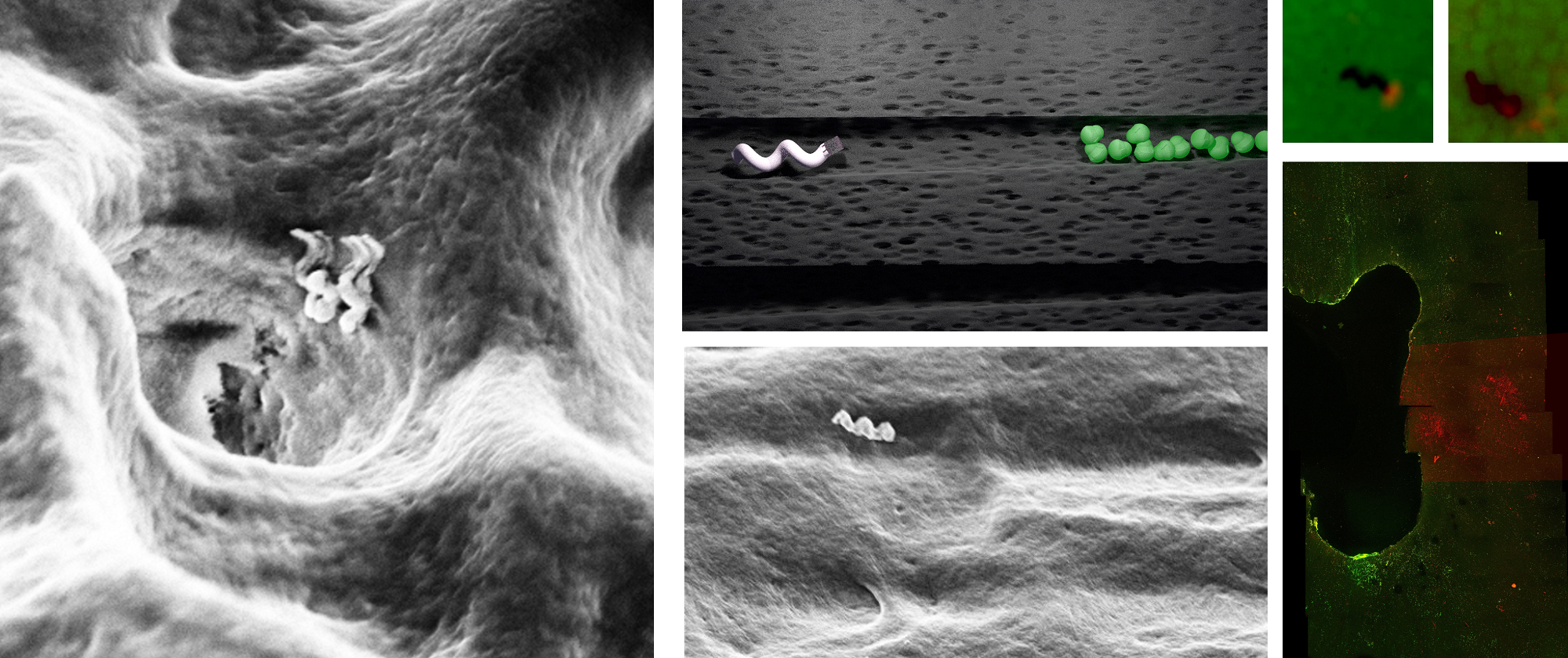A new study by scientists at the Indian Institute of Science (IISc) and Theranautilus, an IISc-incubated firm, indicates that nano-sized robots operated with a magnetic field might help destroy bacteria deep inside dentinal tubules and increase the efficacy of root canal procedures.
 Left: Nanobots entering a dentinal tubule. Centre top and bottom: Schematic representation and electron microscope image of nanobot moving through dentinal tubule to reach the bacterial colony. Right: How locally induced heat from nanobot can kill bacteria. Live bacteria are green and dead bacteria are red. The bottom right shows the band where targeted treatment has been done in human teeth. Image Credit: Theranautilus.
Left: Nanobots entering a dentinal tubule. Centre top and bottom: Schematic representation and electron microscope image of nanobot moving through dentinal tubule to reach the bacterial colony. Right: How locally induced heat from nanobot can kill bacteria. Live bacteria are green and dead bacteria are red. The bottom right shows the band where targeted treatment has been done in human teeth. Image Credit: Theranautilus.
In millions of individuals, root canal treatments are frequently performed to address tooth infections. The affected soft tissue inside the tooth, known as the pulp, is removed, and the tooth is flushed with antibiotics or chemicals to destroy the germs that cause the infection.
However, the therapy frequently fails to eliminate all bacteria, particularly antibiotic-resistant bacteria, like Enterococcus faecalis, which remains concealed inside microscopic channels in the tooth termed dentinal tubules.
The dentinal tubules are very small, and bacteria reside deep in the tissue. Current techniques are not efficient enough to go all the way inside and kill the bacteria.
Shanmukh Srinivas, Research Associate, Centre for Nano Science and Engineering, Indian Institute of Science
Srinivas was also the co-founder of Theranautilus.
The team designed helical nanobots constructed of silicon dioxide coated with iron that can be operated using a device that produces a low-intensity magnetic field, according to the report published in Advanced Healthcare Materials. These nanobots were then introduced into removed tooth samples and monitored with a microscope.
The scientists were able to make the nanobots travel at will and extend down inside the dentinal tubules by adjusting the magnetic field’s frequency. “We have also established that we can retrieve them … we can pull them back out of the patient’s teeth,” says Srinivas.
Importantly, the researchers were able to adjust the magnetic field to cause the nanobots’ surfaces to emit heat, which can kill germs nearby.
No other technology in the market can do this right now.
Debayan Dasgupta, Research Associate, Centre for Nano Science and Engineering, Indian Institute of Science
Dasgupta was also a co-founder of Theranautilus.
To enhance the efficacy of root canal therapy, researchers have previously employed ultrasonic or laser pulses to induce shockwaves in the fluid used to flush away germs and tissue debris. However, these pulses can only penetrate up to 800 μm and lose their energy quickly. The nanobots may go significantly deeper, up to 2,000 μm. The researchers claim that killing bacteria with heat is a safer option than harsh chemicals or antibiotics.
Theranautilus is the result of several years of research in Professor Ambarish Ghosh’s lab at CeNSE on magnetically controlled nanoparticles. His team and others earlier demonstrated that such nanoparticles could catch and move items using light, swim through blood and within living cells, and attach to cancer cells firmly.
“These studies have shown that they are safe to use in biological tissues,” says Dasgupta.
The dental nanobots were tested in mice models and proven to be safe and productive. Researchers are also working on a new type of medical gadget that will let the dentist implant and operate nanobots inside the tooth during root canal therapy.
“We are very close to deploying this technology in a clinical setting, which was considered futuristic even three years ago,” says Ghosh. “It is a joy to see how a simple scientific curiosity is shaping into a medical intervention that can impact millions of people in India alone.”
Journal Reference:
Dasgupta, D., et al. (2022) Mobile Nanobots for Prevention of Root Canal Treatment Failure. Advanced Healthcare Materials. doi.org/10.1002/adhm.202200232.
Source: https://iisc.ac.in/